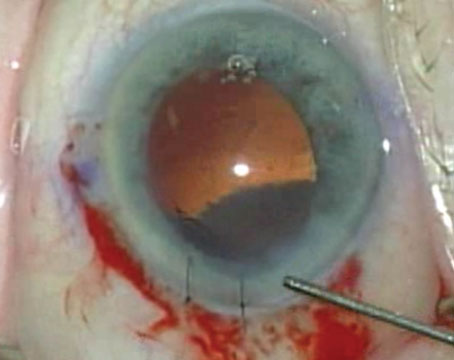However, not all technology is equally important when you're in the trenches using it every day. Some advances sound better in theory than they turn out to be in practice; others receive a lot of hype, but turn out to be more bark than bite. To help sort out what really matters, we asked a number of phaco surgeons to talk about the features of their favorite machines they've found to be most important.
High-Tech Fluidics
"Today, all the machines from major manufactures provide much more refined fluidics than we had previously," says Dr. Nichamin. "Learning how to best employ that technology to aid the nuclear disassembly and aspiration process is where the rubber meets the road."
 |
| Surgeons appreciate the fluidic options available as part of the Advanced Flow System in Bausch & Lomb"s Millennium. |
Dr. Nichamin says that he has always favored the Millennium's venturi technology, which allows him to move quickly and efficiently. "In the past some manufacturers deprecated this technology, saying it was too fast, too dangerous," he notes. "But today, peristaltic systems have come to emulate that increased efficiency." (Bausch & Lomb notes that the Millennium's Advanced Flow System and Custom Control Software now let you choose between a venturi or peristaltic system.)
Aron Rose, MD, associate clinical professor at the Yale University Schools of Medicine and Nursing and in private practice in New Haven, Conn., uses AMO's Sovereign phaco system, and has been using the latest software upgrade, WhiteStar ICE, for several months. He reports that among other things it produces "extraordinary" chamber stability. "I've had a virtual absence of post-occlusion surge," he says. According to AMO, the upgrade includes a Chamber Stabilization Environment feature that proactively adjusts vacuum levels within milliseconds of an occlusion. (See chart, page XX.)
Jack A. Singer, MD, in private practice at Singer Eye Center in Randolph, Vt., has used Surgical Design's Ocusystem Advantage since 1988. He says that controlling the intraocular environment is his top priority. "The surge prevention in the new Ocusystem Advantage provides true surge prevention, not just dampening or reduction," he says. "It's so good that I don't have to compromise with flow and vacuum. I've been working with flow rates up to 48 cc per minute, with vacuum limits set at 500 mmHg, and I don't have to worry about surges or chamber fluctuations."
Dr. Singer is also impressed with the system's automated "freeflow" feature. "A special valve allows the aspiration outflow to bypass the pump," he explains. "The infusion freely flows into the eye and out just using gravity, providing enough traction to pull wispy strands of lens cortex into the port. It's the safest way to clean and work near the lens capsule. If the tip is occluded, any vacuum builds up very slowly, and is very minute—I once measured it at 4 or 5 mmHg. And the footswitch makes it easy to go back and forth between using the pump and linear freeflow."
Dr. Nichamin offers a warning regarding vacuum levels when comparing phaco machines. "Some of the companies tout ultra-high vacuum levels," he says. "However, equating the same vacuum level on two different machines can be misleading. The impact of that number depends on the caliber of needle and other fluidic parameters. In any case, the ultimate quest isn't necessarily for the highest numerical values. We all use higher levels of vacuum than we used to, but there's a little bit of hype out there as to how important that number is.
Predictability
James A. Davison, MD, FACS, who practices at the Wolfe Eye Clinic in Marshalltown, Iowa, primarily uses Alcon's Infiniti. He says that the most important aspect of any phaco system is its predictability. "When you use equipment," he observes, "it has to behave the way you think it's going to. It's like playing the piano; when you're well-rehearsed, things are happening faster than you can think. If you push your foot down a quarter of an inch, you expect to see a certain kind of behavior at the tip. If you don't get exactly what you expect, you can find yourself in a difficult situation."
Dr. Davison says that he has found the Infiniti to be highly predictable. "I occasionally use another major phaco system," he says, "but when you do something thousands of times, you start to notice subtle differences between machines. I find that the other system doesn't give me the same level of predictability and control."
|
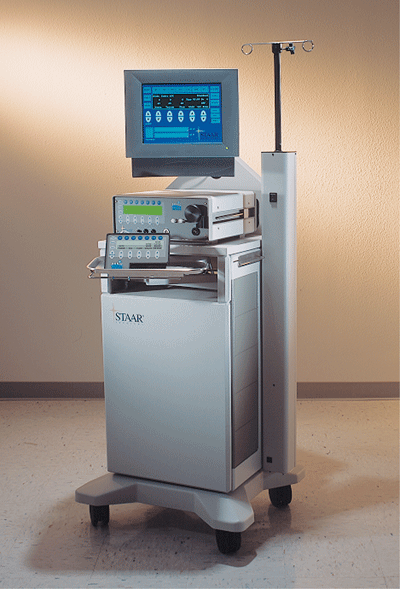 |
| Staar"s Sonic Wave receives high marks for durability, performance, and reliable customer service. |
Durability and Customer Service
David W. Shoemaker, MD, founder of the Center for Sight in Sarasota, Fla., uses Staar's Sonic Wave phaco system. He says that as a self-described "meat and potatoes" user, he values instrument longevity. "The Sonic Wave delivers the characteristics I'm looking for—followability, minimal chatter and great chamber hydrodynamics—and it's a workhorse," he says. "It works day in and day out. We've done 35,000 cases with these machines, and they just keep on humming like the Eveready battery commercial."
Dr. Shoemaker says that when his practice purchased its Staar machines five years ago, he and his coworkers tried everything on the market. "I felt at the time that this was hands down the best machine," he says. "It gave us great intraoperative performance. Of course, a lot has happened in the past five years. I keep waiting for these machines to break so I can try some new ones, but they don't break!"
Dr. Shoemaker notes that an ambulatory surgery center owner will also be concerned about service and costs.
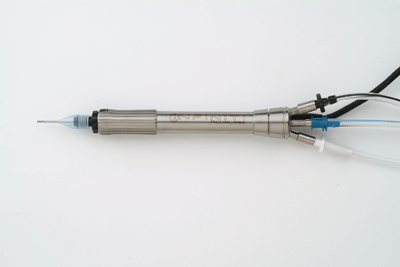 |
| Surgeons note that in addition to removing soft cataracts quickly without using ultrasound, Aqualase (Alcon"s Infiniti) is useful for specific tasks such as rinsing away epithelial cells, and say its smooth tip makes these procedures safer. |
"As surgery center owners, we care about things like disposable tubing, which the Sonic Wave offers," he says. "And service has been excellent—we have a great relationship with the company. We do have a backup machine if something needs repair, but on rare occasions both machines may need some kind of work. They get us a new machine within 24 hours. If a handpiece wears out, they replace it quickly. They keep our machines rolling."
Minimizing Energy Inside the Eye
Another point that our surgeons widely agreed upon was the importance of technology that reduces the amount of energy used inside the eye. Dr. Rose says that he was unprepared for the advantages of the micropulse technology used in AMO's Sovereign phaco system when he first encountered it. "Sovereign's WhiteStar technology drastically reduces the amount of total ultrasonic energy delivered inside the eye while improving efficiency," he says. "Followability is greatly enhanced, postop inflammation is decreased and my patients' postop visual acuities have improved.
"In addition," he continues, "I've performed in vivo thermal readings and found that the phaco tip always stays cool regardless of nuclear density, so the potential for wound burn is essentially negated." Dr. Rose says that he does a lot of bimanual surgery through tight incisions using sleeveless instruments, so this is of great importance to him. He also notes that Variable WhiteStar (version 6.0) has given him "an extraordinary degree of control over every aspect of ultrasound and fluidics," allowing him to decrease ultrasound delivery even further.
 |
| Surgeons say they value the predictability of Alcon"s Infiniti, as well as options like Hyperpulse modulation, which reduces energy levels and increases followability. |
Dr. Rose says that he's also been using AMO's newest software upgrade, WhiteStar ICE. (According to AMO, ICE allows balanced salt solution to flow between the phaco tip and cataract material at the beginning of each energy pulse, acting as a transient cavitation accelerator and improving cutting efficiency.) "Clinically, this gives me even better followability, as well as using less phaco energy and lower volumes of BSS. This can be especially helpful for cases with vulnerable corneal endothelium."
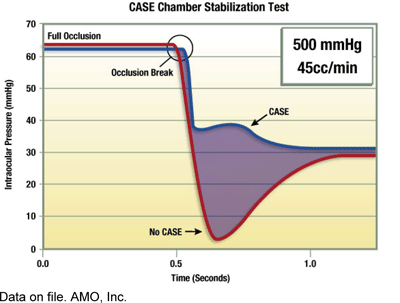 |
| Chamber Stabilization Environment technology (CASE) is part of the Sovereign"s WhiteStar ICE upgrade. According to AMO, it reduces surge by approximately 56 percent when using a 20-ga. tip. |
Dr. Singer, who performs surgery with Surgical Design's Ocusystem Advantage, uses its ability to customize energy delivery to adjust for every grade of lens density, as well as to maximize the effectiveness of specific maneuvers. "I use four different duty cycles," he says. "Not only can you program the duty cycles, you can program the length of the burst and the length of the pause [between bursts]." Dr. Singer has reported success in fine-tuning all of these characteristics to reduce chatter at the lens tip and create what he calls "magnetic followability" using the system's Cobra tip.
Dr. Davison, who uses Alcon's Infiniti, says the machine's programmable energy delivery does a great job of effectively using small amounts of phaco energy. He favors the "hyperpulse" modulation. "It makes your ultrasound energy use even lower, because you don't use the energy continuously," he says. "All these things help you hold onto the piece and draw the material in using less phaco energy. It stays at the tip, which makes the process a lot easier."
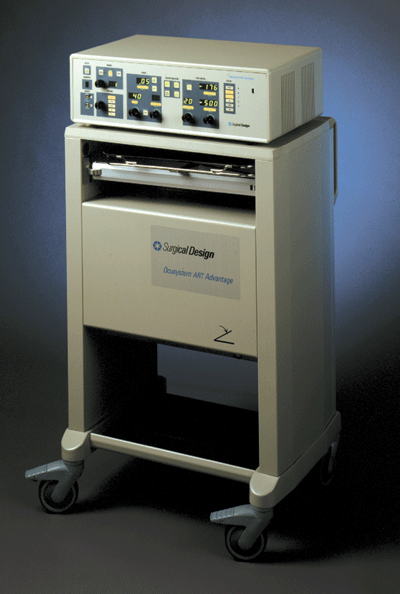 |
| Surgeons say the Ocusystem provides true surge prevention (not dampening) and allows highly customizable energy delivery. |
Lens Removal Without Ultrasound
As part of the drive to minimize or eliminate heat inside the eye, manufacturers have developed many alternatives to standard ultrasound, such as the Sonic Wave system's low frequency emulsifier (40-500 Hz), which Staar says uses up to 1,000 times less energy than standard ultrasound. Taking this idea even further, Alcon developed Aqualase, a non-ultrasound alternative that uses fluid micropulses to break up a cataractous lens. However, this technology has limits, most notably an inability to easily break up very dense cataracts. (One skeptical surgeon notes that soft cataracts can be aspirated without using ultrasound energy or Aqualase, although he concedes that there could be an advantage if Aqualase were used in concert with other technological advances such as Neosonix, which causes the phaco tip to oscillate.)
 |
| The Horizon Phacoemulsification System from American Optisurgical offers a full range of anterior cataract functions and programmability in a lightweight, portable unit. |
Jeffrey D. Horn, MD, medical director of Vision for Life in Nashville, Tenn., says he uses Aqualase a lot, and that changing his technique to prechopping the lens has made the Aqualase technology especially effective. "I tend to use it on patients under the age of 70 with less than 3+ nuclear sclerotic cataracts," he notes. "Aqualase is a safe technique in part because it uses a smooth tip; if it comes into contact with the capsule, it's very unlikely the capsule will rupture." Nevertheless, Dr. Horn says that as cataracts become more dense, the advantages of Aqualase are outweighed by the extra time required to remove the lens. "The more time you stay inside the eye, the more likely it is that something will go wrong."
|
James A. Davison, MD, FACS, of the Wolfe Eye Clinic in Marshalltown, Iowa, likes Aqualase and sees it as having real promise as a way to rinse off epithelial cells at the end of a case. "It's neat technology," he says, "but it takes a little longer, so it misses that triad of faster, safer, better. The faster part isn't quite there. Plus, expense is an issue. Nevertheless, it is safer, so we're happy that we committed to using it."
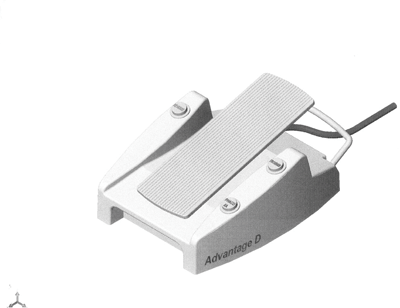 |
| Surgeons say they value the control offered by a dual-linear footpedal, available with Surgical Design"s Ocusystem (above) and Bausch & Lomb"s Millennium. |
Dr. Davison seems to understand the more skeptical point of view some surgeons express. "When Alcon invented the Aqualase, I'm sure they thought it would be a really good thing for people who don't do a lot of phaco," he says. "But then they made the ultrasound technology so much better that you almost don't need it."
Infusion Sleeve Design
Dr. Singer says another feature of the Ocusystem that he values is the design of the infusion sleeve, useful for preventing wound burn. "The first Surgical Design phaco system in 1979 had a titanium infusion sleeve," he says. "It couldn't be pinched off, so it maintained the flow of fluid to cool the tip. Then they designed a rigid plastic infusion sleeve. However, neither conformed to the incision very well, causing occasional incisional outflow that shallowed the anterior chamber.
"To solve that problem they developed a flexible silicone sleeve with an internal spiral rib that prevents the sleeve from being pinched off by a tight incision," he continues. "Yet the sleeve is flexible, so it conforms to the shape of the incision and seals the outflow. That's been available since 1992." Dr. Singer notes that the MacKool Dual Sleeve (from Alcon) also offers the same advantage, with an inner rigid sleeve and outer flexible one.
Dual-linear Footpedal
Dr. Nichamin notes that choosing between phaco machines is partly an issue of how high-tech you want to go. "Do you want to drive a Corvette, a Ferrari or a Maserati?" he asks. "I'm a Millennium user because I like venturi fluidics, but I've become dependent on the dual-linear footpedal. It lets me control both vacuum and power simultaneously." (According to the manufacturer, you can also use to control flow and power simultaneously, and you can use both flow and vacuum response in the same procedure.)
